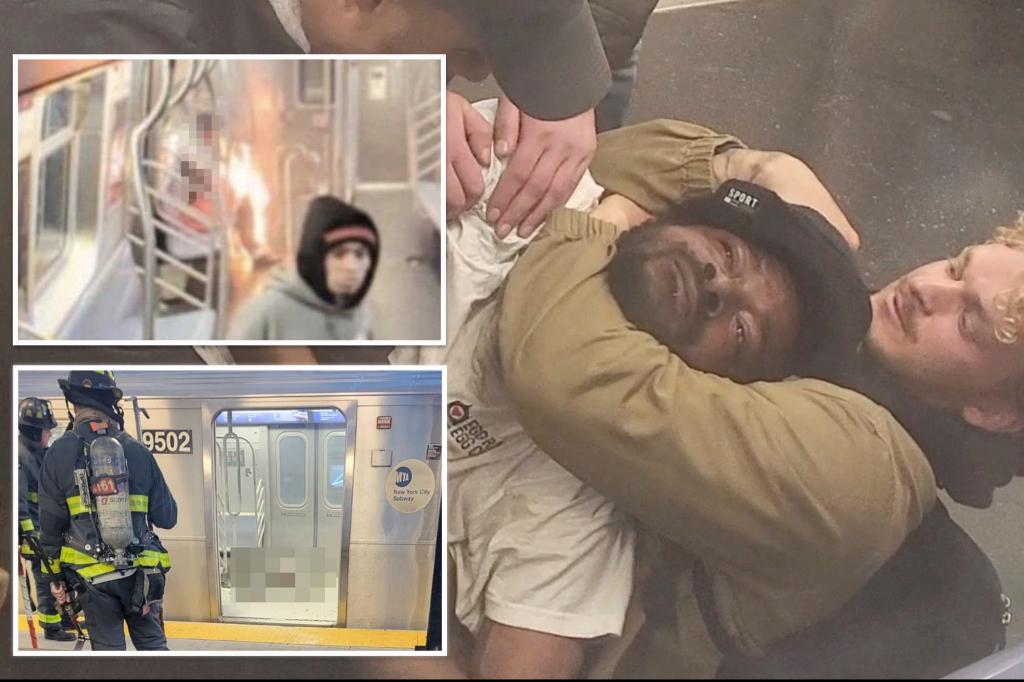The death of an unidentified woman aboard a Brooklyn subway train has ignited a firestorm of controversy and fear in New York City, raising questions about bystander intervention, the city’s handling of mental illness, and the safety of the transit system. The incident, which involved a Guatemalan immigrant allegedly setting the sleeping woman on fire, was captured on video, revealing the disturbing inaction of several bystanders who witnessed the horrific event unfold. This tragedy has fueled a complex debate about civic responsibility, the legal ramifications of intervening in violent situations, and the perceived decline of public safety in the city.
The video footage of the incident shows a stark contrast between the horrifying reality of the burning woman and the apparent apathy of those around her. At least three individuals can be seen observing the scene, with one even filming the event on their phone. An NYPD officer is also present outside the subway car but does not immediately intervene. This lack of action has been attributed by some, like Guardian Angels founder Curtis Sliwa, to the “Daniel Penny effect,” a reference to the recent acquittal of a man who fatally choked a homeless man on the subway. Sliwa argues that the fear of legal repercussions, stemming from Penny’s initial arrest and subsequent trial, has created a chilling effect on bystander intervention, leaving individuals hesitant to get involved in potentially dangerous situations.
The incident has sparked a broader discussion about the legal and ethical implications of intervening in violent situations. While some argue that individuals have a moral obligation to assist those in danger, others point to the potential legal risks, as highlighted by the Daniel Penny case. The fear of being wrongly accused or facing legal consequences can deter individuals from taking action, even when witnessing a horrific event like the subway fire. The debate underscores the complex interplay between personal responsibility, legal liability, and the perceived risks associated with intervening in violent situations. It raises questions about how to balance the need for public safety with the protection of individual rights.
Beyond the issue of bystander intervention, the incident has also brought renewed attention to the city’s handling of mental illness and homelessness. The alleged perpetrator, identified as Sebastian Zapeta-Calil, is a migrant with a history of mental health issues. This has led some to criticize the city’s approach to mental health care, arguing that insufficient resources and support systems have left vulnerable individuals on the streets and in the subway system, posing a risk to themselves and others. Critics argue that a more comprehensive approach to mental health care, including increased access to treatment and supportive services, is crucial to addressing the root causes of such tragedies.
The incident has also exposed shortcomings within the MTA and its response to emergencies. Questions have been raised about the delayed police response, the failure to utilize fire extinguishers present on the subway car, and the ease with which the alleged perpetrator was able to leave the scene before being apprehended later. State Senator Leroy Comrie, who chairs the committee overseeing the MTA, has demanded answers from the transit agency, seeking a thorough investigation into the events leading up to and following the incident. He has also pointed to the broader issue of inadequate mental health services, emphasizing the need for greater support and resources to address the growing number of mentally ill individuals in the city’s public spaces.
The tragic event has elicited sharp criticism of Governor Kathy Hochul and her administration’s handling of public safety. Former Assemblyman Dov Hikind has called on the Governor to resign, citing the incident as evidence of her inability to effectively manage the state and ensure the safety of its citizens. He referenced Hochul’s recent pronouncements about subway safety, made just a day before the incident, arguing that they demonstrate a disconnect from the reality of the situation. This criticism reflects a broader concern about the perceived decline of public safety in New York City, and the growing frustration among some residents who feel that the government is not doing enough to address the problem.
In conclusion, the horrific death of the woman on the Brooklyn subway has served as a stark reminder of the complex challenges facing New York City. The incident has ignited discussions about bystander apathy, the legal implications of intervening in violent situations, the city’s approach to mental health and homelessness, and the overall safety of the transit system. The tragedy underscores the need for a multi-faceted approach to addressing these issues, involving improved mental health services, enhanced safety measures in the subway system, and a renewed focus on fostering a sense of civic responsibility among New Yorkers. The incident has left a deep scar on the city’s psyche, prompting a critical examination of the systemic issues that contributed to this tragedy and a call for meaningful action to prevent similar incidents from occurring in the future.

